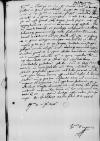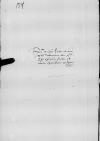Legi ea omnia, quae Gdańsk Town Council ⌊GdanensesGdańsk Town Council ⌋ et dominus Johann von Werden (Constellatus, cf. HE, No. 148, p. 150, footnote No. 12) (*1495 – †1554), 1526 Mayor of Gdańsk (Danzig), from 1527 Starost of Neuenburg (Nowe), 1532-1535, 1538, 1539, 1546, 1551 Burgrave of Gdańsk, from 1535 Starost of Preußisch Mark (Przezmark) (1535-1540 together with Achatius von Zehmen (Cema)), 1536/1537 envoy of the Council of Royal Prussia to the Diet of the Kingdom of Poland held in Cracow (SBPN 4, p. 433-435; ZDRENKA 2, p. 368-369; MAŁŁEK 1976, p. 93, 161)⌊Ioannes a WerdenJohann von Werden (Constellatus, cf. HE, No. 148, p. 150, footnote No. 12) (*1495 – †1554), 1526 Mayor of Gdańsk (Danzig), from 1527 Starost of Neuenburg (Nowe), 1532-1535, 1538, 1539, 1546, 1551 Burgrave of Gdańsk, from 1535 Starost of Preußisch Mark (Przezmark) (1535-1540 together with Achatius von Zehmen (Cema)), 1536/1537 envoy of the Council of Royal Prussia to the Diet of the Kingdom of Poland held in Cracow (SBPN 4, p. 433-435; ZDRENKA 2, p. 368-369; MAŁŁEK 1976, p. 93, 161)⌋ scripsit.[1] Calculus Gdańsk Town Council ⌊illosGdańsk Town Council ⌋, ut recte Dominatio Vestra Reverendissima omina written over e⌈eaa written over e⌉tur, male habet. Eo omisso non est, quod Sigismund I Jagiellon (Zygmunt I) (*1467 – †1548), King of Poland and Grand Duke of Lithuania (1506-1548); Duke of Głogów (Glogau) (1499-1506), Duke of Opava (1501-1506), Governor of Silesia (1504-1506); son of King Kazimierz IV Jagiellon and Elisabeth of Austria⌊maiestati regiaeSigismund I Jagiellon (Zygmunt I) (*1467 – †1548), King of Poland and Grand Duke of Lithuania (1506-1548); Duke of Głogów (Glogau) (1499-1506), Duke of Opava (1501-1506), Governor of Silesia (1504-1506); son of King Kazimierz IV Jagiellon and Elisabeth of Austria⌋ scribi possit, nisi ut expostulemus, verum non convenit neque expedit. Ne tamen muti taceamus et paulopost indigniora intolerabilioraque patiamur (quod certe futurum ex Diet of Poland ⌊conventu CracoviensiDiet of Poland ⌋ arbitror), omnino sic scribendum esse, ut posterius Dominatio Vestra Reverendissima concepit, censeo. Velim tamen et illud inseri, quod ea, quae in iis scripsi, hortatu omnium scripserim. Idipsum minime odiosum erit dabitque argumento vigorem.[2]
Viaticum, quod Dominatio Vestra Reverendissima dabit veredario, curabitur, ut in Provincial Diet of Royal Prussia ⌊novissimo conventuProvincial Diet of Royal Prussia ⌋ Dominationi Vestrae Reverendissimae rependatur. Non enim ex dignitate est, ut illud vel alius tabellarius a civitatibus petatur.
Mitto domini doctoris Stanisław Hozjusz (Stanisław Hosz, Stanislaus Hosius) (*1504 – †1579), diplomat and theologian; 1534-1538 secretary to the Bishops of Cracow Piotr Tomicki and Jan Chojeński; 1538-1549 royal secretary; 1538-1549 Canon of Ermland (Warmia) and from 1539 Cantor; 1540-1550 Canon of Cracow; 1549-1551 Bishop of Kulm (Chełmno); 1551-1579 Bishop of Ermland; in 1560 elevated to Cardinal; 1561-1563 Papal Legate to the General Council of Trent; in 1573 appointed Grand Penitentiary to Pope Gregory XIII (SBKW, p. 95-96; KOPICZKO 2, p. 129-130)⌊HosiiStanisław Hozjusz (Stanisław Hosz, Stanislaus Hosius) (*1504 – †1579), diplomat and theologian; 1534-1538 secretary to the Bishops of Cracow Piotr Tomicki and Jan Chojeński; 1538-1549 royal secretary; 1538-1549 Canon of Ermland (Warmia) and from 1539 Cantor; 1540-1550 Canon of Cracow; 1549-1551 Bishop of Kulm (Chełmno); 1551-1579 Bishop of Ermland; in 1560 elevated to Cardinal; 1561-1563 Papal Legate to the General Council of Trent; in 1573 appointed Grand Penitentiary to Pope Gregory XIII (SBKW, p. 95-96; KOPICZKO 2, p. 129-130)⌋ cf. Stanisław HOZJUSZ (HOSIUS) to Ioannes DANTISCUS Cracow, 1539-02-05, CIDTC IDL 2069⌊litterascf. Stanisław HOZJUSZ (HOSIUS) to Ioannes DANTISCUS Cracow, 1539-02-05, CIDTC IDL 2069⌋. Vereor, ne nostra Isabella Jagiellon (*1519 – †1559), 1539-1559 Queen of Hungary; from 1539 wife of John Zápolya, King of Hungary, mother of John II Sigismund Zápolya; daughter of Sigismund Jagiellon, King of Poland, and Bona Sforza⌊IsabellaIsabella Jagiellon (*1519 – †1559), 1539-1559 Queen of Hungary; from 1539 wife of John Zápolya, King of Hungary, mother of John II Sigismund Zápolya; daughter of Sigismund Jagiellon, King of Poland, and Bona Sforza⌋ contra Suleiman the Magnificent (*1494 – †1566), 1520-1566 Sultan of the Ottoman Empire⌊TurciSuleiman the Magnificent (*1494 – †1566), 1520-1566 Sultan of the Ottoman Empire⌋ voluntatem in Hungary (Kingdom of Hungary)⌊HungariamHungary (Kingdom of Hungary)⌋ profecta gravia nobis bella pariat.[3] Cum illa nos, qui Suleiman the Magnificent (*1494 – †1566), 1520-1566 Sultan of the Ottoman Empire⌊TurciSuleiman the Magnificent (*1494 – †1566), 1520-1566 Sultan of the Ottoman Empire⌋ amici esse volebamus, hostes declaravimus. Scribitur mihi, quod pro hac instante vere vel omnem occupare Hungary (Kingdom of Hungary)⌊HungariamHungary (Kingdom of Hungary)⌋, vel oppetere statuerit, et quod attritus classe, deinceps non nisi terra illum pugnaturum. Vehementer aiunt Suleiman the Magnificent (*1494 – †1566), 1520-1566 Sultan of the Ottoman Empire⌊eumSuleiman the Magnificent (*1494 – †1566), 1520-1566 Sultan of the Ottoman Empire⌋ hoc matrimonio irritatum etc.
Dominationem Vestram Reverendissimam diutissime optime valere summopere cupio.


 BCz, 245, p. 134
BCz, 245, p. 134